Cultivated mushrooms : special assortment
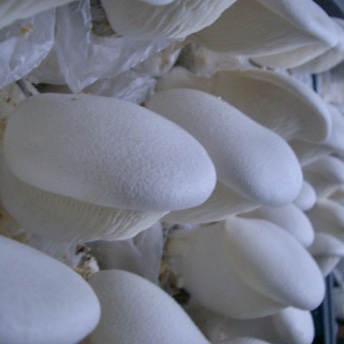
| Int. trade name | ABALONE / AKURATAKI |
| LATIN | Pleurotus nebrodensis |
| NL | Wit elfje |
| EN | Abalone or White elf |
| FR | Champignon Abalone ou Elfe blanc |
| DE | Abalone-Pilz oder Weisse elf |
| ES | Hongo de Abulón |
| SEASON | Year round |
| HIGH SEASON | Year round |
| ORIGIN | Asia |
| SORTING | Mixed sizes |
The White elf is a juicy mushroom with a slightly peppery taste and a sweetish accent. The Akurataki is best cleaned dry if this is necessary.
Owes its name to its fairytale appearance. Looks like the gray oyster mushrooms, but its shape is 'fuller / fleshier' with a powdery structure on the hat. The color is also lighter than that of the oyster mushroom, sometimes to almost white.
Most Akurataki are grown in China and freshly flown to Europe. Most, however, are canned for the Chinese and Asian markets in particular, where they are sold as 'Abalone mushrooms'. In addition to the Wood (or Judea) ear, this mushroom is widely used in Chinese cuisine.
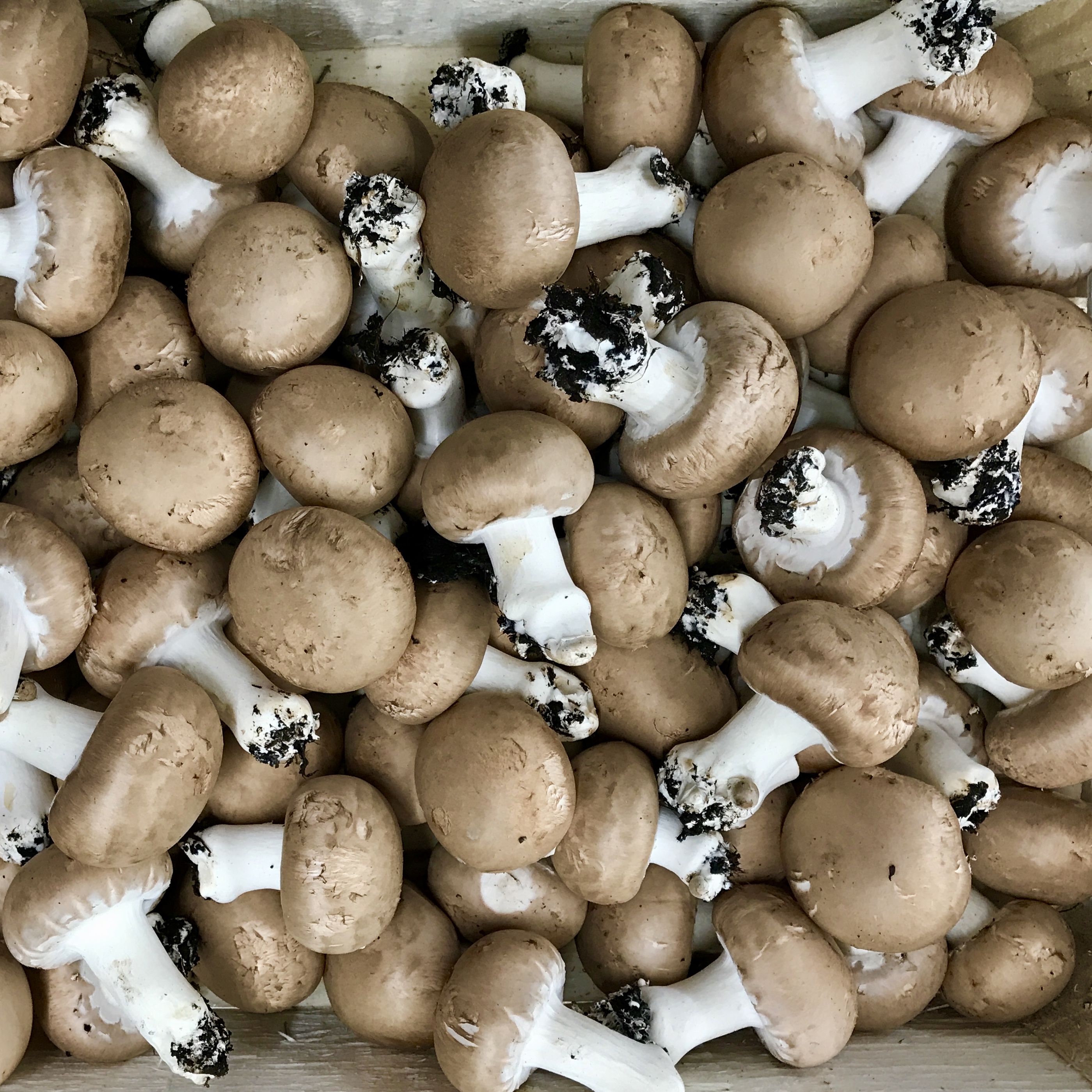
| Int. trade name | CHAMPIGNON DE PARIS |
| LATIN | Agaricus bisporus |
| NL | Grotchampignon (wit / kastanje) |
| EN | Cave button mushrooms (white / chestnut) |
| FR | Champignon des cavernes (blanc / brun) |
| DE | Höhlenpilze (Weiß / Kastanie) |
| ES | Champiñón de cuevas (blanco / marrón) |
| SEASON | Year round |
| HIGH SEASON | Year round |
| ORIGIN | NL / BE / FR |
| SORTING | Mixed sizes / mini |
Because of the stable natural conditions (temperature, humidity, no light and no draft) in cave cultivation, Cave mushrooms have a number of culinary advantages compared to industrially grown mushrooms.
Cave mushrooms grow more slowly, which makes them considerably firmer. They contain less water and release less moisture during preparation. Partly due to the addition of marl to the nutrient medium, Cave mushrooms are also tastier with a more intense 'mushroom flavor'.
Another advantage is that Cave mushrooms (ideally) are not harvested with a knife, but are turned from the soil so that the foot comes along. As a result of that, they also have a longer shelf life.
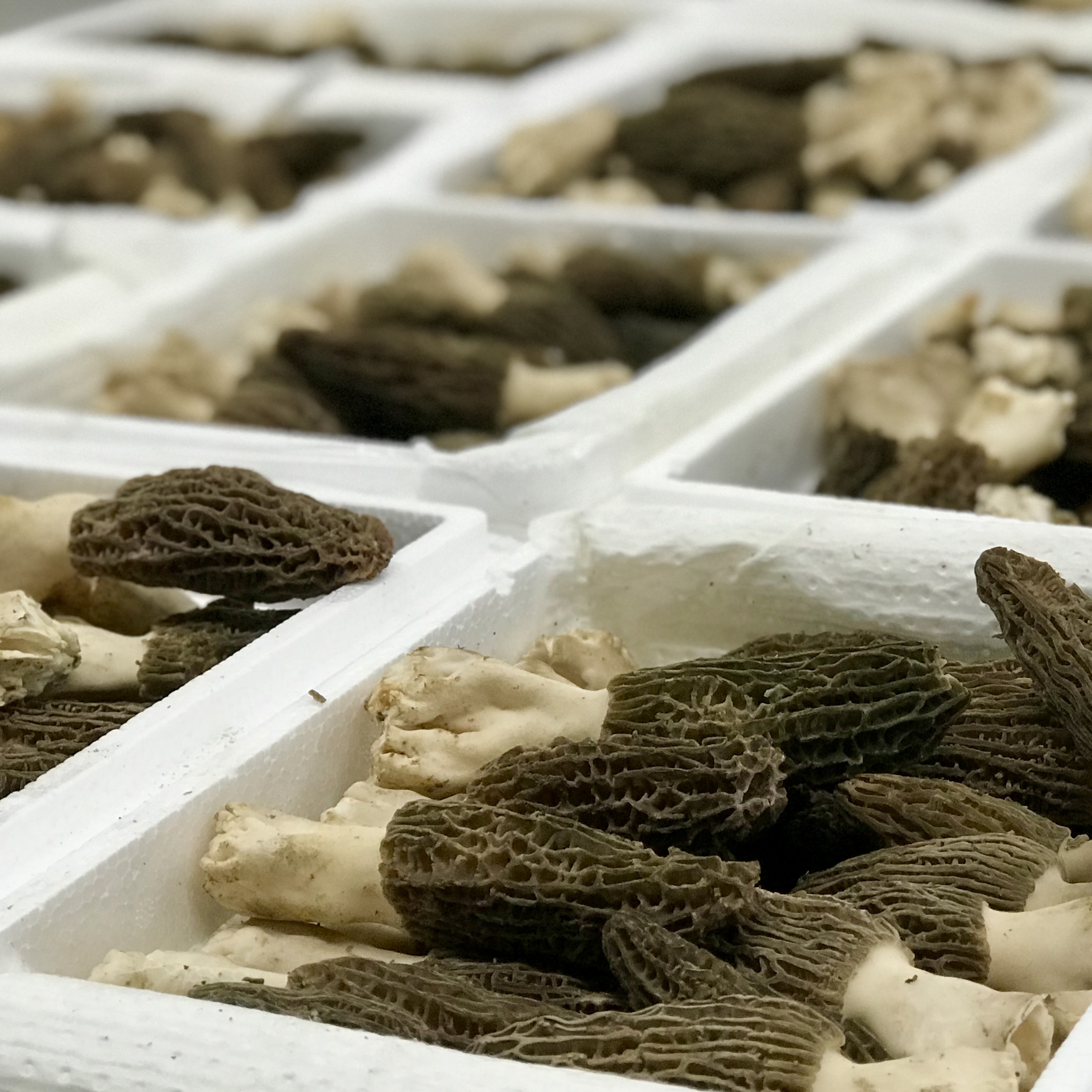
| Int. trade name | CHINESE MOREL |
| LATIN | Morchella conica (synonymous for Morchella elate) |
| NL | Gekweekte morielje |
| EN | Cultured morel |
| FR | Morille cultivé |
| DE | Kultivierte Morchel |
| ES | Colmenilla cultivada |
| SEASON | Year round |
| HIGH SEASON | Year round |
| ORIGIN | CN [ by air] |
| SORTING | Per shipment comparable sizes (4 - 6 cm) |
These Morels are grown in China in 'open ground'. According to some chefs, these morels have "less taste". They prefer to wait for the first wild morels from Turkey and certainly for the later ones at the end of March, beginning of April, from central and eastern Europe.
However, there are many chefs who like to work with this cultivated mushroom. As an extremely decorative accent in various dishes, garnishes, soups and sauces. Because of their great shape and almost comparable sizes, they are also great to fill. In short, a nice addition to the current range and enough reasons to surprise guests.
After 50 years of research at the University of Chengdu, they have succeeded in growing morels. They have been reluctantly grown and sold for 5 years. In the meantime, people grow morels in the open ground in more than 20 Chinese provinces. The lion's share comes from Sichuan (the "granary" of China) in the center of the country. If ordered by us, they will be delivered to our house immediately after picking by air freight after just 24 hours.
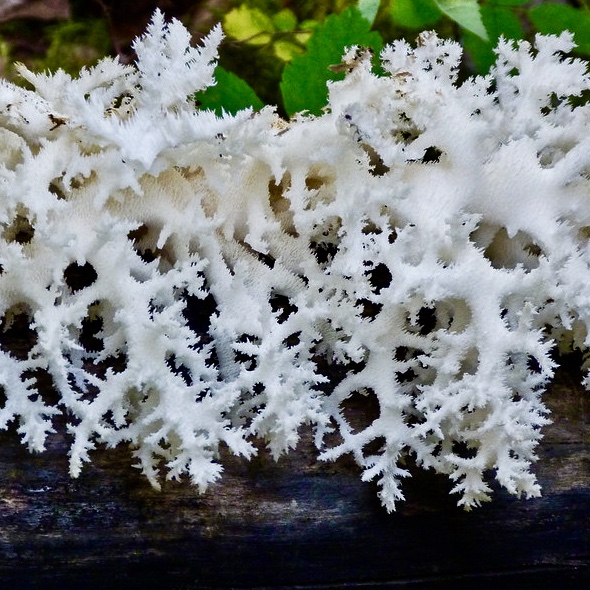
| Int. trade name | CORAL |
| LATIN | Clavulina coralloides |
| NL | Koraalzwam |
| EN | Coral fungus |
| FR | Clavaire ou Champignon de corail |
| DE | Kammförmige Keulenpilz oder Kammkoralle |
| ES | Seta coral o Salvaje |
| SEASON | Year round |
| HIGH SEASON | Year round |
| ORIGIN | EU |
| SORTING | Mixed sorting / regular or Bio |
Coral fungus smells and tastes like radish. Has a bitterness, but also something nutty and fruity in taste. The Coral mushroom quickly loses its crispy texture due to its fragile structure. It is therefore advisable to prepare very briefly and to add the Coral mushroom to a dish shortly before serving. In terms of shape, it combines nicely with frisee lettuce (curly endive) as a short-fried or tempura-fried garnish on, for example a fungi or truffle pizza or in salads. The taste and whimsical appearance therefore comes into its own as a tempura.
The Coral mushroom owes its name to its eccentric shape. Is quite common in the wild, but there are several extremely poisonous species! More sensible, therefore, is to buy cultivated coral mushroom.
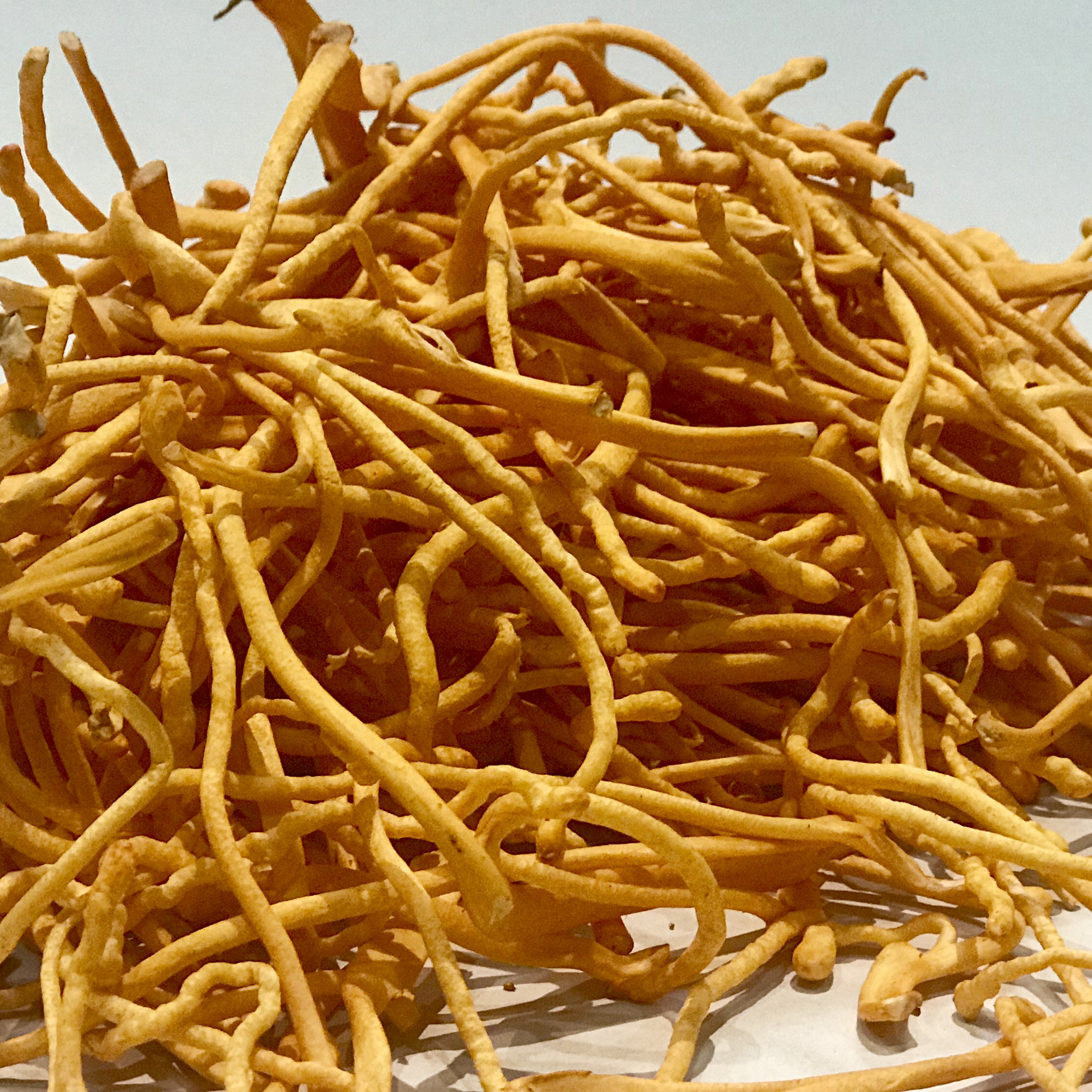
| Int. trade name | CORDYCEPS |
| LATIN | Cordyceps militaris |
| NL | Rupsendoder of Cordyceps (m.) |
| EN | Scarlet caterpillarclub or Cordyceps (m.) |
| FR | Cordyceps militaire |
| DE | Puppen-Kernkeule oder Cordyceps (m.) |
| ES | Cordyceps (m.) |
| SEASON | year round |
| HIGH SEASON | year round |
| ORIGIN | Asia |
| SORTING | Mixed sizes |
The gastronomic value of the Cordyceps militaris are a nice earthy aroma with a hint of sweetness, a beautiful decorative shape and deep orange color. If you search via Google under 'codyceps dish', you will also find some common recipes and ideas with the cultivated Cordyceps militaris. You can also find a recipe with Cordyceps under "Recipes" on our website. Again a nice story to tell to your guests !!
The 'Cordyceps militaris' are cultivated. And no, not on a breeding ground of live insects like his 'wild brother' the parasitic 'Cordyceps sinensis'. But on starchy culture media (rice / potatoes) with manipulated mycelium from the wild version. Responsible and organic. It is claimed that this variant also has a wide range of medicinal and stimulating effects.
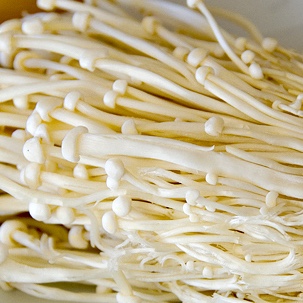
| Int. trade name | ENOKI |
| LATIN | Flammulina velutipes |
| NL | Fluweelpootje of Enoki |
| EN | Velvet paw or Enoki |
| FR | Collybie à pied velouté ou Enoki |
| DE | Samtfußrübling oder Enoki |
| ES | Pata de Terciopelo o Enoki |
| SEASON | Year round |
| HIGH SEASON | Year round |
| ORIGIN | Asia / NL / DK |
| SORTING | Main stream / BIO |
The mild taste of the White Enoki is sweet, fruity and slightly spicy. The texture is firm and tender, with a crispy `bite`. Therefore excellent (shortly blanched or stir fried) in salads, spring rolls, sandwiches etc.
Enoki is a cultivated form of the Velvet paw, which also occurs in the wild in the Netherlands and Belgium. Then they are light brown in color with short feet and larger hats. The white cultivated Enoki owes its color to the fact that they are grown in the dark, and their long stalks by adding extra CO2. Enoki are particularly popular in Japan. They have been growing there Enoki for 300 years.
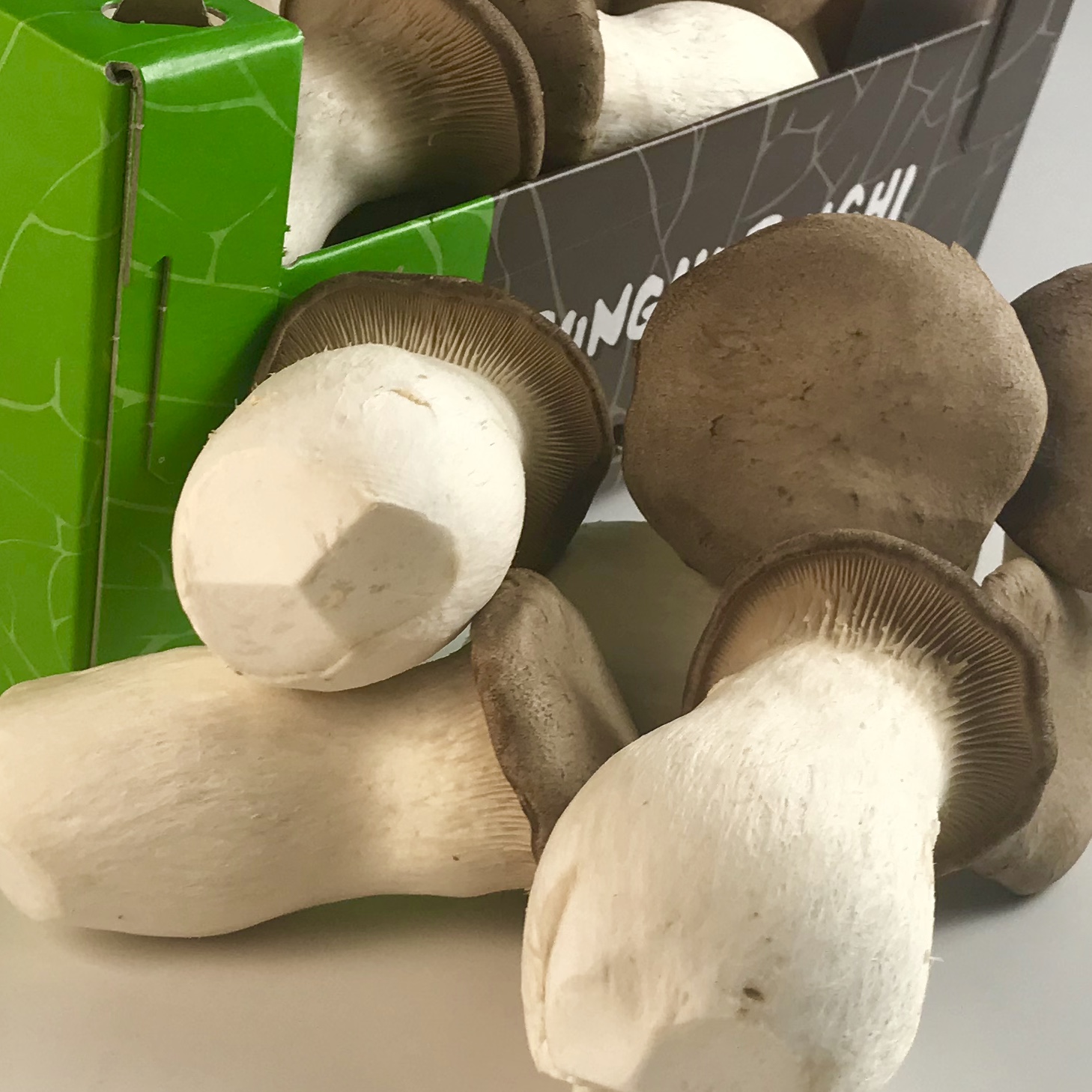
| Int. trade name | ERYNGII |
| LATIN | Pleurotus eryngii |
| NL | Koningsoesterzwam |
| EN | King oyster mushroom |
| FR | Pleurote du panicaut ou Pied de dunes |
| DE | Kräuterseitling |
| ES | Seta de cardo |
| SEASON | Year round |
| HIGH SEASON | Year round |
| ORIGIN | Asia |
| SORTING | Large / middle / mini / [ by air ] middle / mini [ by boat ] |
Raw Eryngii have hardly taste, but fried or grilled they have a rich, slightly spicy Umami taste. The structure is firm and resembles Abalone (a very large edible marine snails). Because they are relatively large, you can also process the King Oyster Mushroom as a pulled mushroom or as a nice long Juliènne in soups or rolls.
We personally find them with a bit of oil and garlic, grilling and a few drops of soy sauce the most beautiful. . .
The Eryngii is the largest variant of the genus of the oyster mushrooms. It grows in the wild around the Mediterranean and in Asia. Here it is now grown on a large scale and shipped by boat or plane. In this package they can be kept for a long time.
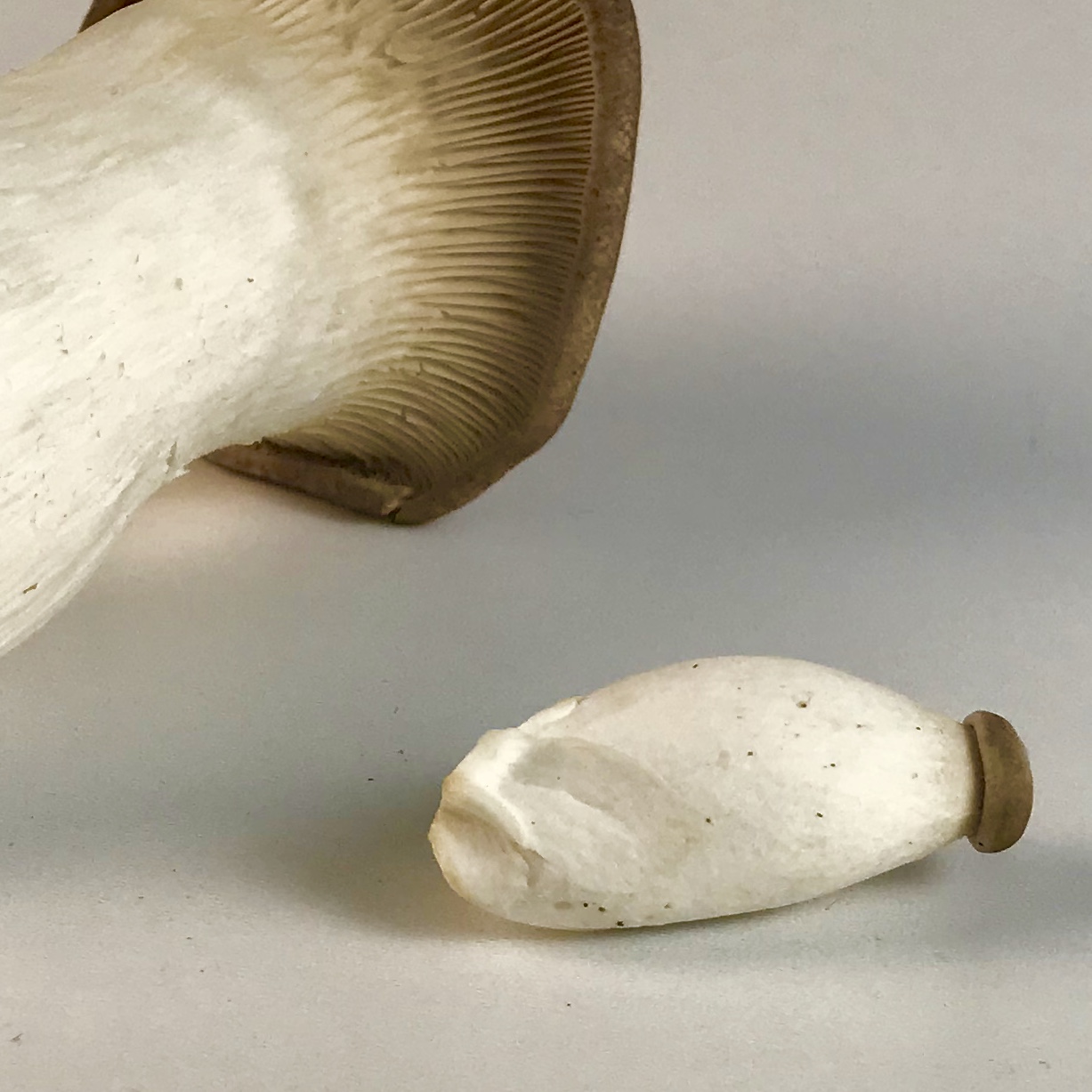
| Int. trade name | ERYNGII [ MINI ] |
| LATIN | Pleurotus eryngii |
| NL | Koningsoesterzwam mini |
| EN | King oyster mushroom mini |
| FR | Pleurote du panicaut mini |
| DE | Kräuterseitling mini |
| ES | Seta de cardo mini |
| SEASON | Year round |
| HIGH SEASON | Year round |
| ORIGIN | Asia |
| SORTING | Mixed sizes [ 3 - 5 cm ] |
These mini King oyster mushrooms also have a long shelf life.
Raw they have little taste, but baked or grilled they have a rich, slightly spicy Umami taste. In addition, they are extremely decorative small mushrooms in soups, sauces and in all kinds of garnishes.
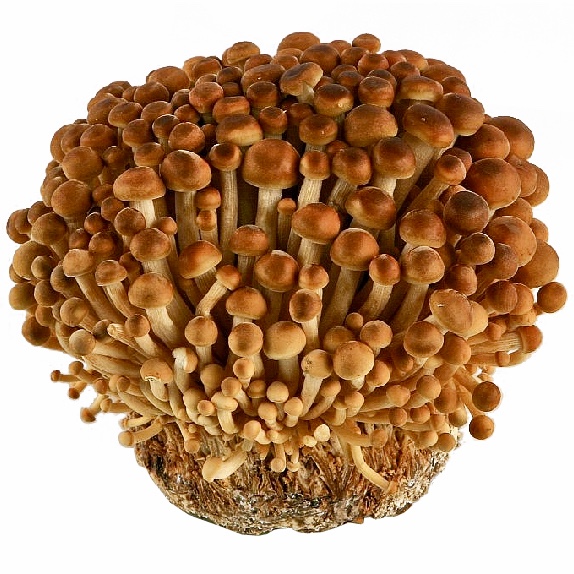
| Int. trade name | GOLDEN ENOKI |
| LATIN | Flammulina velutipes |
| NL | Gouden fluweelpootje |
| EN | Golden needle mushroom |
| FR | Enoki d'or |
| DE | Goldener Nadelpilz |
| ES | Seta de aguja de oro |
| SEASON | Year round |
| HIGH SEASON | Year round |
| ORIGIN | Asia |
| SORTING | In bundles |
The mild taste of the Golden Enoki can be described as sweet, fruity, slightly spicy and necessary. The texture is firm and tender, with a crispy bite. Can therefore be processed perfectly in salads, in "spring rolls", between sandwiches and the like. Because of the fragile structure you can best prepare them briefly.
The very young ones are often no bigger than a pinhead and therefore offer chefs wonderful and fine decorative options.
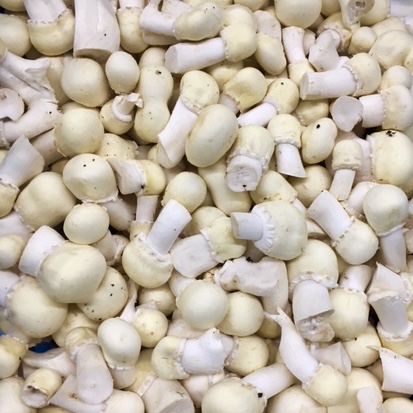
| Int. trade name | HORSE / ANICE |
| LATIN | Agaricus arvensis |
| NL | Akker paddenstoel of Gewone anijschampignon |
| EN | Horse mushroom |
| FR | Agaric des jachères ou Boule de neige |
| DE | Weiße Anis-Champignon oder Schaf-Egerling |
| ES | Seta de Carvalho |
| SEASON | Year round |
| HIGH SEASON | Year round |
| ORIGIN | EU |
| SORTING | Mixed sorting |
The Horse mushroom smells and tastes clearly like anise. Does it very well in combination with fish dishes such as quiches in which fennel, roasted fennel seed or a drop of Pernod processed. But also stir fried or short blanched in a salad or 'just' in an omelet.
Clean with a brush and cut off the bottom piece of the stem. Cut them into slices or quarters and do not cook or fry too long, otherwise the delicate and special anise flavor will evaporate.
The younger ones, with a white stem and slightly yellowish and oval-shaped hat, are the tastiest. Older copies color (eventually dark) brown.
The Horse or Anise- or Meadow Mushroom is family of the white button mushroom and grows wild on meadows and in spruce forests. Is difficult to distinguish from a toxic 'lookalike'. Therefore, it is better cultivated and available throughout the year.
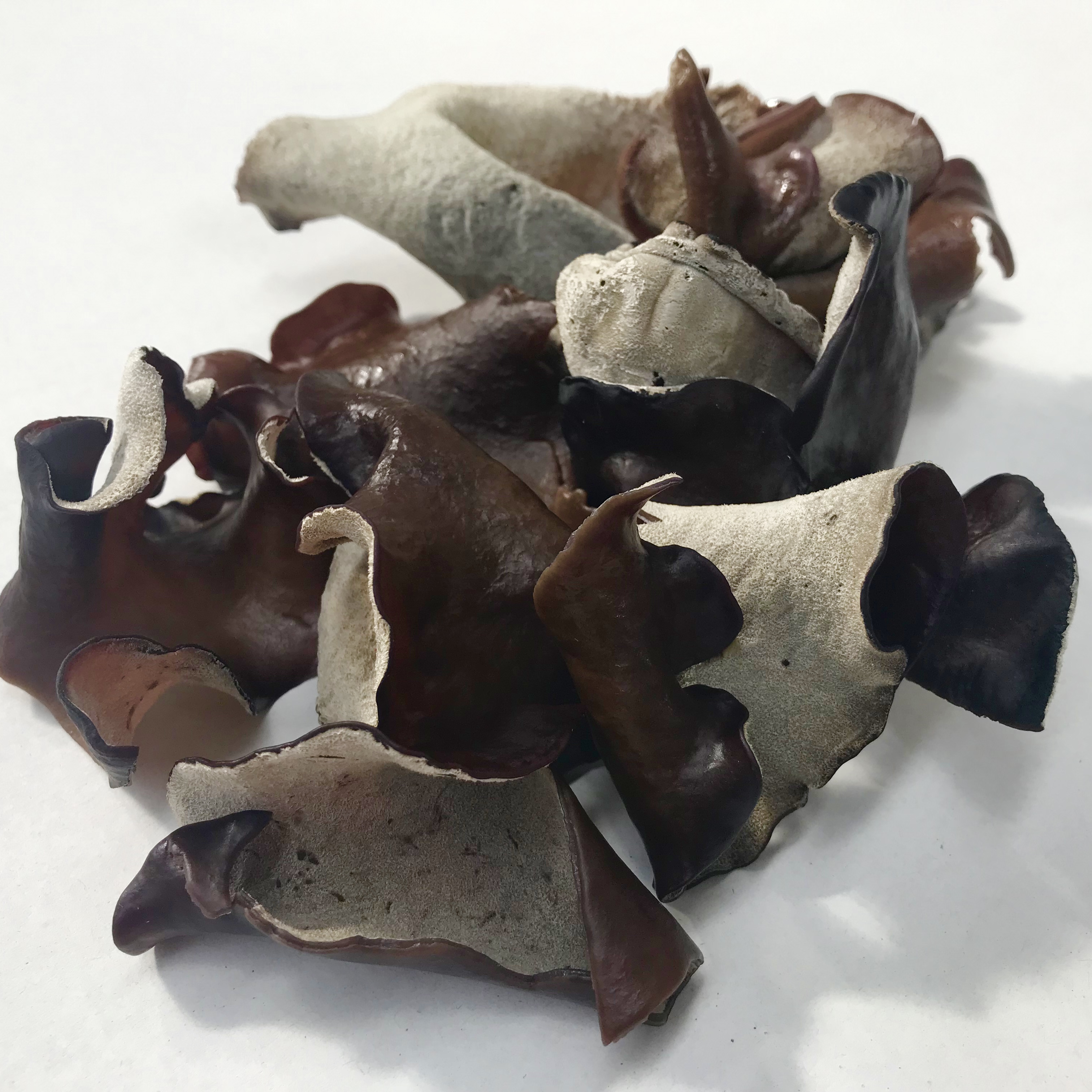
| Int. trade name | JUDEA EAR |
| LATIN | Auricularia auricula-judae |
| NL | Judas oor |
| EN | Wood ear or Judea ear |
| FR | Oreille de Judas |
| DE | Judasohr |
| ES | Oreja de Judas |
| SEASON | year round |
| HIGH SEASON | year round |
| ORIGIN | Asia |
| SORTING | Mixed sorting |
Wood ear has little taste, but easily absorbs flavors during the drying of dried ones or during cooking in a sauce or soup. Especially the gelatinous, rubbery texture makes it popular in Chinese and Japanese cuisine.
The gelatinous structure in Asian sauces with vegetables and chicken (and often bonded with tapioca) gives a pleasant mouthfeel. Indispensable in the famous Hot & Sour soup !!
Wood ear occurs almost everywhere in the wild. With the elder tree as favorite host. Is one of the top 5 most cultivated mushrooms worldwide (2003: approx. 1.7 million tons !!). The mushroom looks like an ear and 'breathes', as it were, with moisture; in dry weather, its size decreases, but the day after (in humid weather) it regenerates (grow or swell) just as easily. The color is satiny, dark pink and slightly transparent.
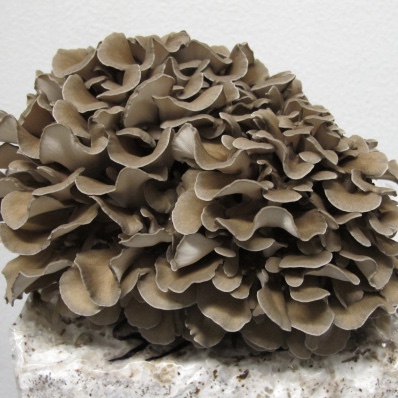
| Int. trade name | MAITAKE |
| LATIN | Grifola frondosa |
| NL | Eikhaas of Maitake |
| EN | Hen of the woods or Maitake |
| FR | Polypore en touffe ou Maitake |
| DE | Gemeine Klapperschwamm oder Maitake |
| ES | Maitake |
| SEASON | year round |
| HIGH SEASON | year round |
| ORIGIN | EU / Asia |
| SORTING | Mixed sizes / small / regular or Bio |
Hen of the woods can best be eaten cooked; baking, grilling, smothering, frying, stir-frying. Delicate taste of hazelnut and pepper. Goes well with Parmesan, Gruyère, thyme. Cut the end of the foot thinly and peel the fungus into similar pieces of the spatula shaped caps.
Maitake is a wood mushroom. In the wild it grows at the foot of living oak trees. Is excellent to cultivate and therefore available throughout the year. In addition to a beautiful decorative appearance and delicate taste, the mushroom is one of the most miraculous and healing organisms on our planet; especially against cancer. Is therefore, and for many other reasons, rightly a 'superfood'.
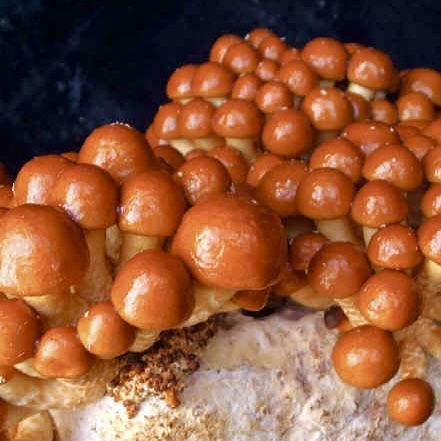
| Int. trade name | NAMEKO |
| LATIN | Pholiota nameko |
| NL | Bundelzwam of Goudkopje |
| EN | Nameko or Golden head |
| FR | Naméko ou Tête d'or |
| DE | Nameko oder Goldkäppchen oder Toskanapilz |
| ES | Nameko o Cabeza dorada |
| SEASON | Year round |
| HIGH SEASON | Year round |
| ORIGIN | EU |
| SORTING | Mixed sorting, both mainstream and BIO |
The taste of Nameko is nutty and the structure has a nice 'bite'. Characteristic is the somewhat sticky head. This layer provides a light binding effect in dishes such as Miso soup, ragouts or casseroles. The stickiness disappears after preparation. The Nameko mushroom also does well in taste and decor in wok dishes and pastas. It is recommended to prepare it as a whole mushroom.
Clean with a wet piece of kitchen paper.
The Nameko mushroom is also called 'Golden head' because of its copper, gold or amber-like color. The foot, and the flesh of the cap, are yellowish. After proper preparation, they retain this color and thereby give a nice accent to a dish.
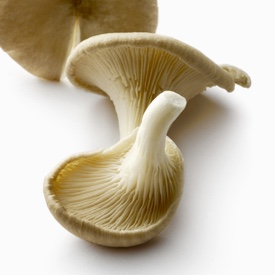
| Int. trade name | OYSTER [ MINI ] |
| LATIN | Pleurotus ostreatus |
| NL | Gewone oesterzwam mini |
| EN | Pearl oyster mushroom mini |
| FR | Pleurote en (forme d') huître mini |
| DE | Mini-Austernpilz |
| ES | Gírgola mini o Pleuroto en forma de ostra mini |
| SEASON | Year round |
| HIGH SEASON | Year round |
| ORIGIN | EU |
| SORTING | Mixed sizes [ 3 - 5 cm ] |
The mini Oyster mushroom has even more meatiness and firmness than the larger ones. The taste is also fuller and more concentrated with a modest hint of anise. Combines nicely with fish dishes.
Because of its small size it is wonderful to present in its entirety in a dish. Bake briefly, otherwise they will become tough.
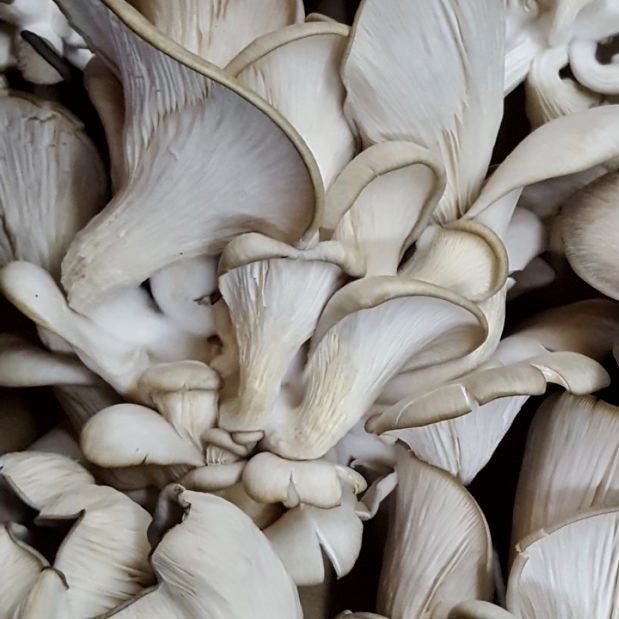
| Int. trade name | OYSTER GREY |
| LATIN | Pleurotus ostreatus |
| NL | Gewone oesterzwam |
| EN | Pearl oyster mushroom |
| FR | Pleurote en (forme d') huître |
| DE | Austernpilz |
| ES | Gírgola o pleuroto en forma de ostra |
| SEASON | Year round |
| HIGH SEASON | Year round |
| ORIGIN | EU |
| SORTING | Mixed sorting / mainstream or BIO |
The taste of the Pearl- or Grey oyster mushroom is soft creamy and the flesh is soft and meaty. Because the oyster mushroom contains less water than, for example, a button mushroom, it hardly shrinks during preparation. Because of this it is also called "the vegetarian steak" and is also very suitable for longer preparations in stews or ragouts.
The Oyster mushroom owes its name to its shape; that of an oyster shell. The most common types of the Pearl oyster mushroom are the brownish gray, also called the "Veal oyster mushroom" because of its soft taste that resembles veal. And the light purple, also called "Tonque mushroom" because the taste is a bit like (calf) tongue.
The 'Pearl' or 'Tree oyster mushroom' is a widely eaten mushroom worldwide. He was first cultivated in Germany as a livelihood during the First World War. Since 1980, this mushroom has been grown in the Netherlands on prepared straw to which the 'spawn' (the seed) has been added. For some years, coffee grits, a waste product from coffee consumption, have also been used as a substrate. Oyster mushrooms are now grown commercially all over the world.
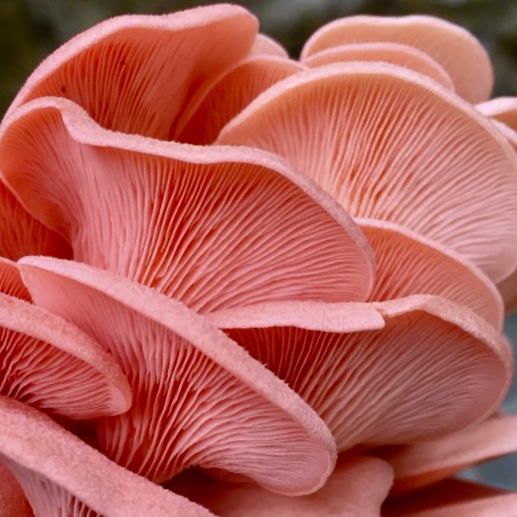
| Int. trade name | OYSTER PINK |
| LATIN | Pleurotus djamor |
| NL | Roze oesterzwam |
| EN | Pink oyster mushroom |
| FR | Pleurote rose |
| DE | Austernpilz rosa |
| ES | Gírgola rosa |
| SEASON | Year round |
| HIGH SEASON | Year round |
| ORIGIN | EU |
| SORTING | In bundles |
The Pink oyster mushroom has a fleshy taste and structure with a sweetish accent and is a decorative mushroom because of its color.
Carefully clean the Pink oyster mushroom with a brush or a damp piece of kitchen paper. Cut away the rather tough stem and wedge the oyster mushroom into slices or quarters. Do not clean it under running water or by leaving it in water. They then absorb water and that leads to a loss of taste.
The Pink (and Yellow) oyster mushrooms are not breeding varieties of the common oyster mushroom. They are exotic species from Southeast Asia that have been cultivated there. Available all year round, mostly from Dutch growers.
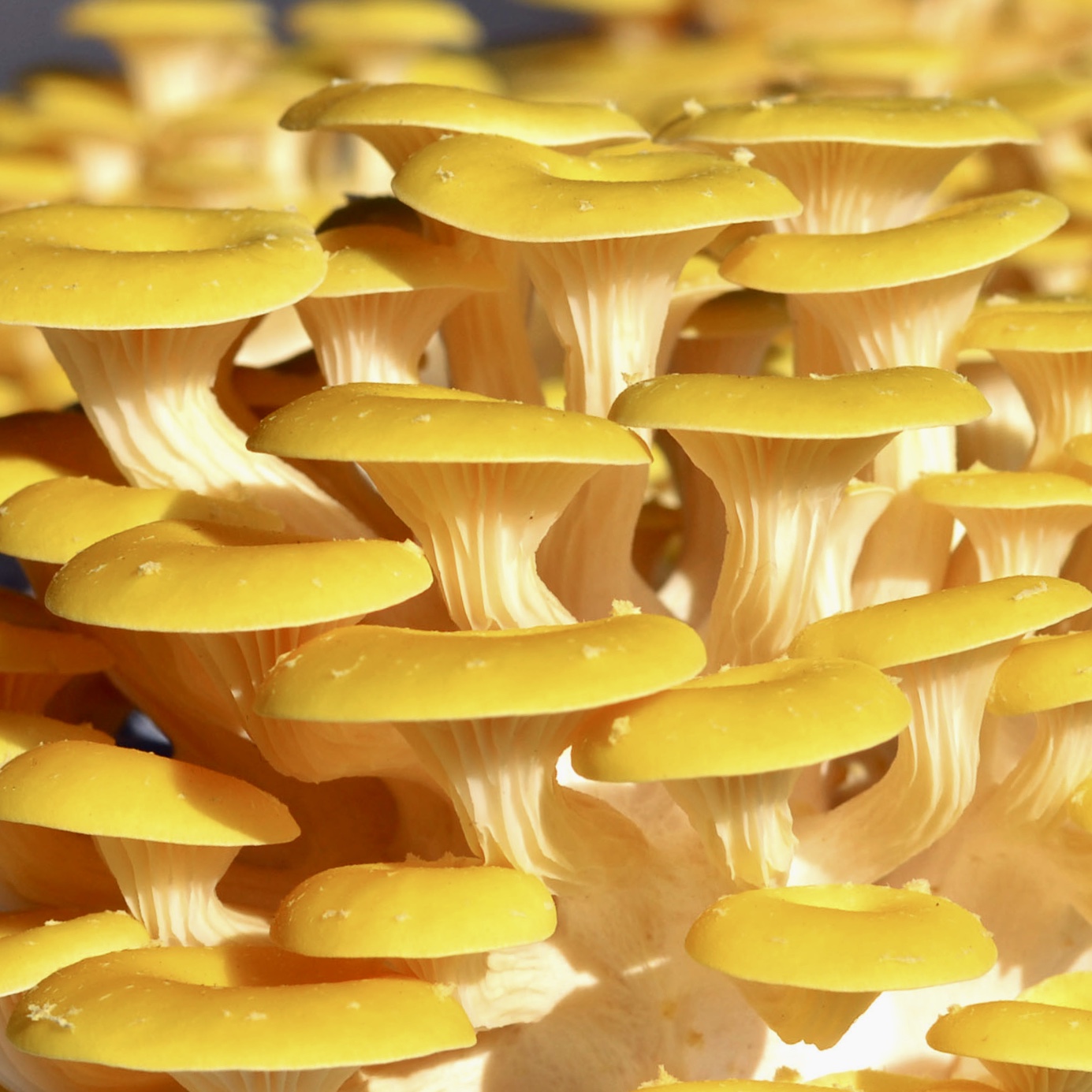
| Int. trade name | OYSTER YELLOW |
| LATIN | Pleurotus cornucopiae var. Citrinopileatus |
| NL | Gele oesterzwam |
| EN | Golden oyster mushroom |
| FR | Pleurote jaune |
| DE | Gelbe Austernpilz oder Zitronengelbe Seitling |
| ES | Gírgola amarillo |
| SEASON | Year round |
| HIGH SEASON | Year round |
| ORIGIN | EU |
| SORTING | In bundles / main stream and BIO |
The Golden or Yellow oyster mushroom tastes (cashew) nutty after preparation and has small slats, which makes it easier to prepare them briefly (preferably in wok dishes). The meat is nicely juicy with a sweet accent.
The Yellow (and Pink) oyster mushroom are not breeding varieties of the common oyster mushroom. They are exotic species from Southeast Asia that have been cultivated there. Available all year round, mostly from Dutch growers.
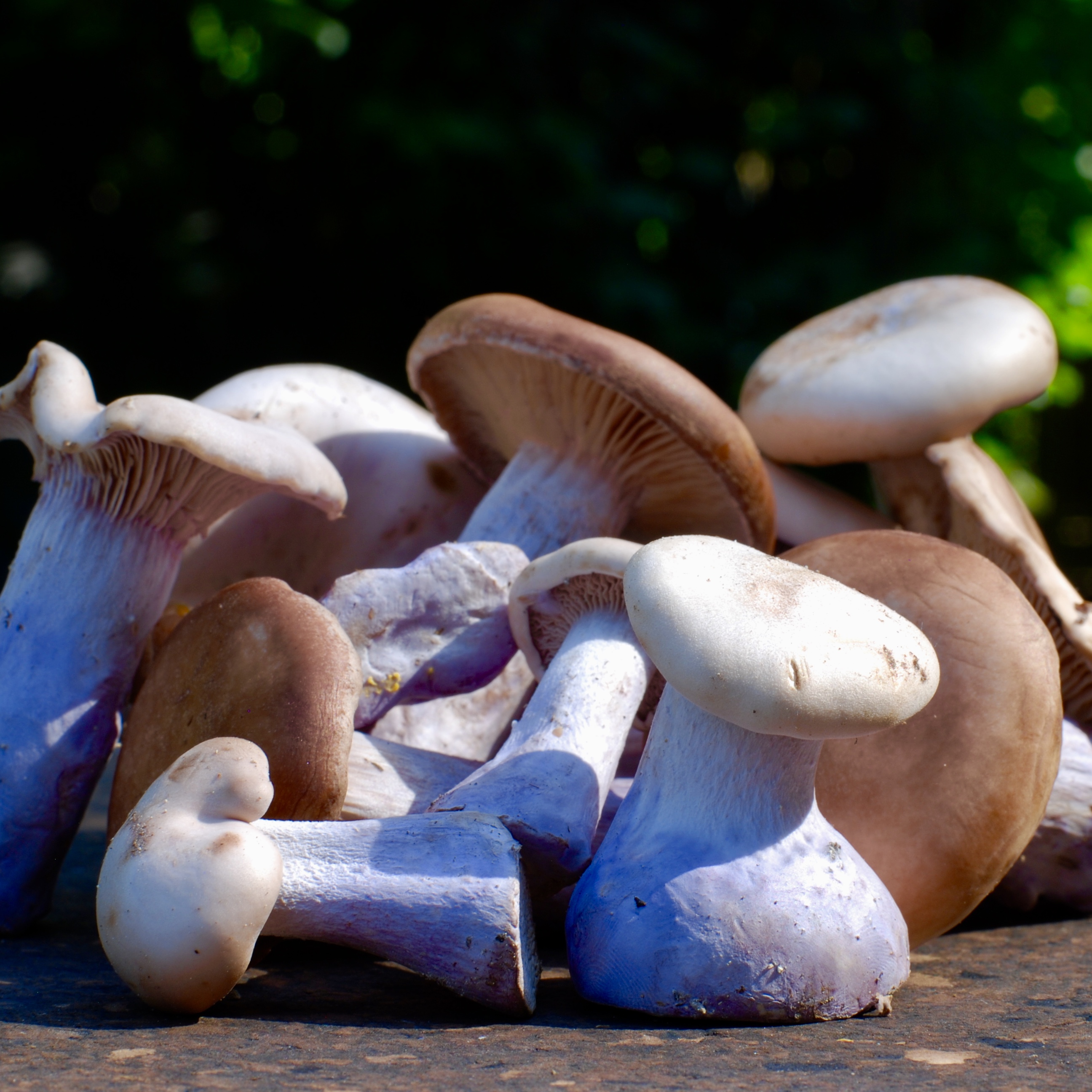
| Int. trade name | PIED BLEU |
| LATIN | Lepista nuda |
| NL | Paarse schijnridder |
| EN | Wood blewit (Blue foot) |
| FR | Pied bleu |
| DE | Violetter Rötelritterling |
| ES | Lepista nuda (Seta de pie azul) |
| SEASON | Year round |
| HIGH SEASON | Year round |
| ORIGIN | BE / FR |
| SORTING | mixed sizes / mini / large |
Pronounced and pure, with a fruity aroma, a light anise flavor and irony perfume. And with a nice fleshy structure. Often fried and served in a creamy sauces, on toast and excellent to combine in fish dishes.
Consuming Wood blewit raw is not recommended and usually gives allergic reactions and indigestion. But by frying them, the toxic substances disappear and the 'Pied bleu' is a tasty mushroom.
This mushroom is cultivated on a small scale in marl caves and is available almost all year round. In the wild from the end of the summer till the first frost. Grows in groups and sometimes in fairy rings. Characteristic is the violet, purple-blue foot that actually says: 'don’t touch me, don’t eat me'. After all, in nature, blue is the color of poison.
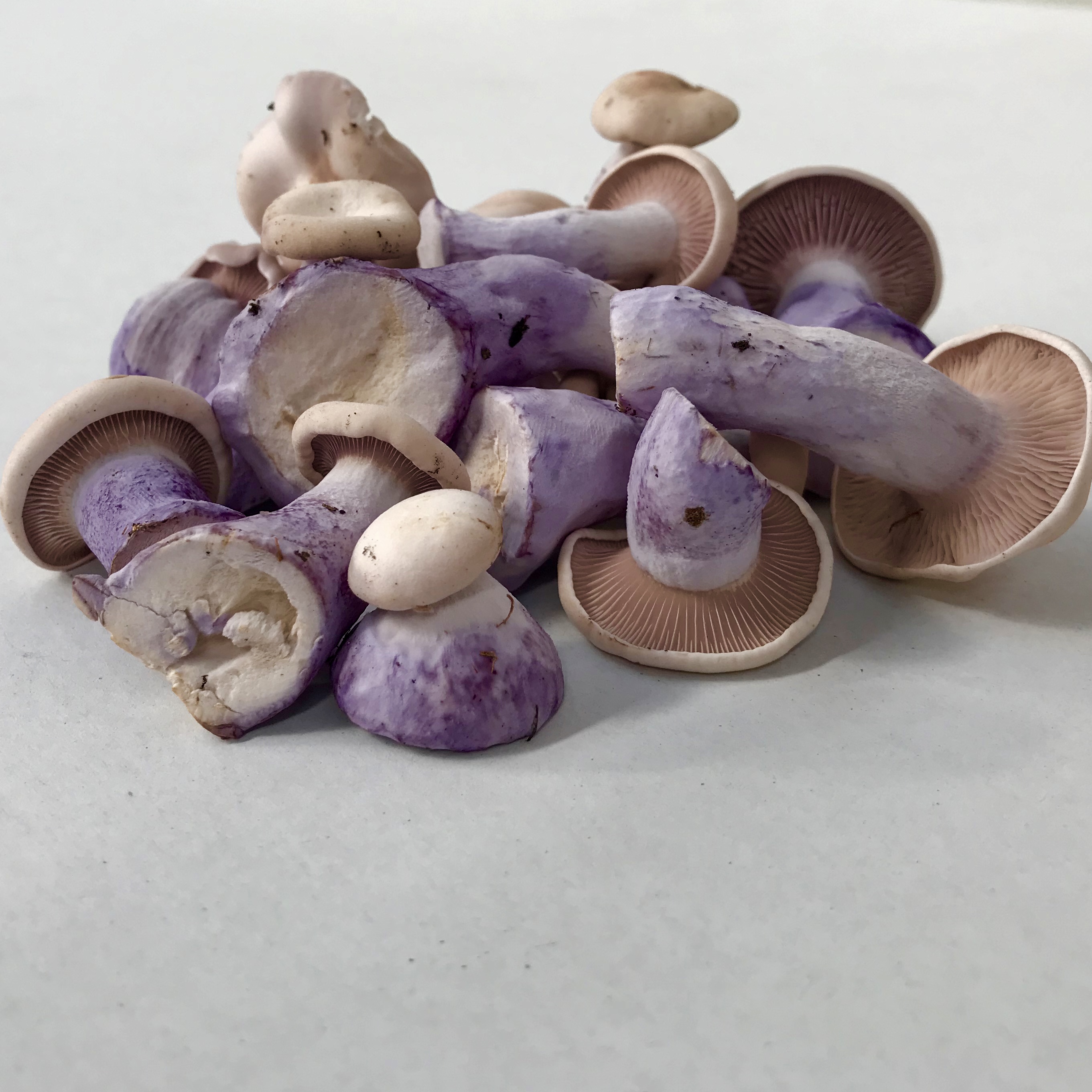
| Int. trade name | PIED BLEU [ MINI ] |
| LATIN | Lepista nuda |
| NL | Paarse schijnridder mini |
| EN | Wood blewit (Blue foot) mini |
| FR | Pied bleu mini |
| DE | Violetter Rötelritterling mini |
| ES | Seta de pie azul mini |
| SEASON | Limited supplies |
| HIGH SEASON | Limited supplies |
| ORIGIN | EU |
| SORTING | 4 - 7 CM |
The taste of these small mushrooms is more concentrated than the larger ones. Pronounced and pure, with a fruity aroma, a light anise flavor and iron-like perfume. And with a nice fleshy structure.
Use them as a whole or cut them (after cleaning with a damp cloth) in half or in quarters. Bake briefly and you have a beautiful, decorative, colorful and aromatic mushroom.
The Blue foot is cultivated on a small scale in marl caves and is available almost all year round. Due to the small-scale production, the minis (which are previously picked from the beds) are even more scarce and are picked to order.
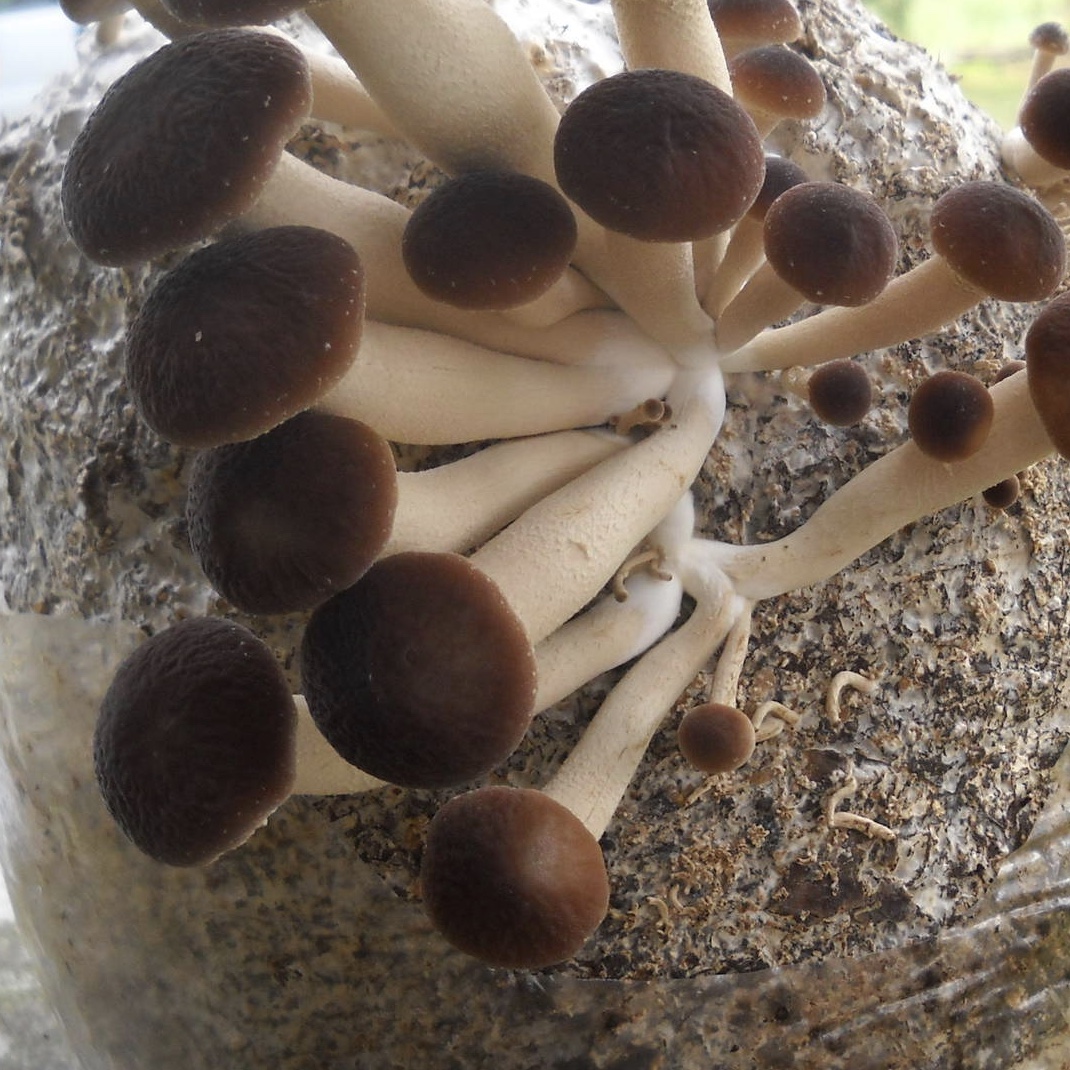
| Int. trade name | PIOPPINO |
| LATIN | Agrocybe aegerita / Cyclocybe aegerita |
| NL | Populier leemhoedje |
| EN | Pioppino or Chestnut mushroom |
| FR | Pioppino ou Agrocybes du peuplier |
| DE | Pioppino oder Südlicher Ackerling |
| ES | Pioppino o Seta de chopo |
| SEASON | year round |
| HIGH SEASON | year round |
| ORIGIN | EU |
| SORTING | Mixed sizes |
The excellent taste is pronounced aromatic, has a sweet and some chestnuts. The fragrance is pleasantly soft with a hint of flower. The structure is nicely fleshy and firm.
Washing of this mushroom is not necessary and is very suitable to use in salads. In many other dishes it is an extremely decorative appearance.
Pioppino grows in nature at the foot of poplars, elder trees and mulberry. The Romans and Greeks have already begun to cultivate this mushroom, in principle for the recycling of tree stumps. Soon the Pioppino became a delicacy in France and Italy.
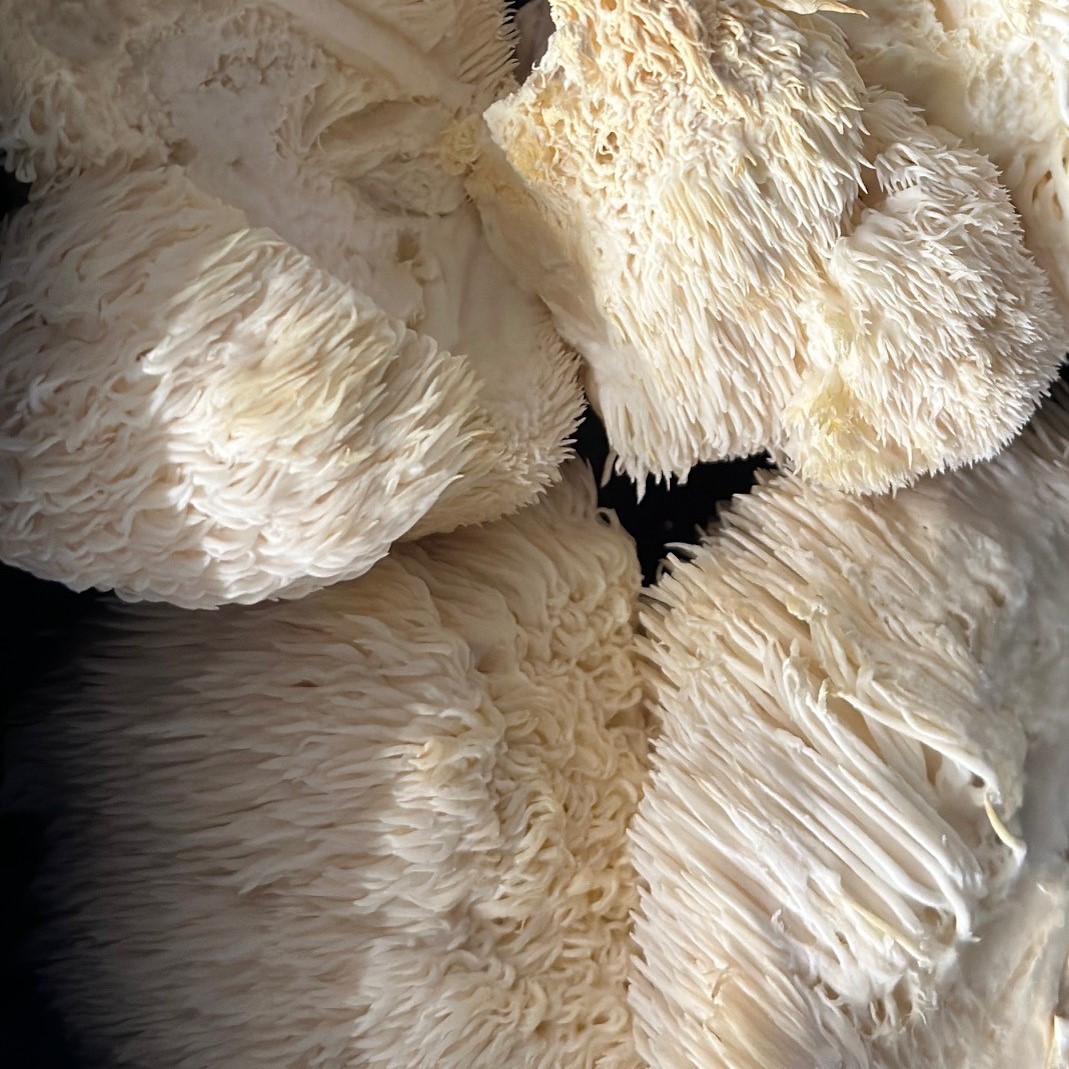
| Int. trade name | POM POM |
| LATIN | Hericium erinaceus |
| NL | Pruikzwam of Apekop |
| EN | Pom pom mushroom or Lion's mane mushroom |
| FR | Pom pom blanc |
| DE | Igel-Stachelbart oder Affenkopfpilz |
| ES | Melena de león |
| SEASON | year round |
| HIGH SEASON | year round |
| ORIGIN | EU |
| SORTING | Regular and Bio |
A beautiful mushroom with many benefits for the chef !! Practical: affordable, no cleaning required, available throughout the year. Culinary: in addition to its distinctive and decorative appearance, the mushroom has firm meat and a mild, sweet taste.
Some compare the taste with that of lobster or crab, others recognize a hazelnut in the slightly sweetish tone.
You can cut them into slices, cubes or strips and then bake them. Some chefs fill the balls and then cook them.
Our Pom Pom blanc are cultivated. In the wild, it grows on the wounds of mainly beech trees.
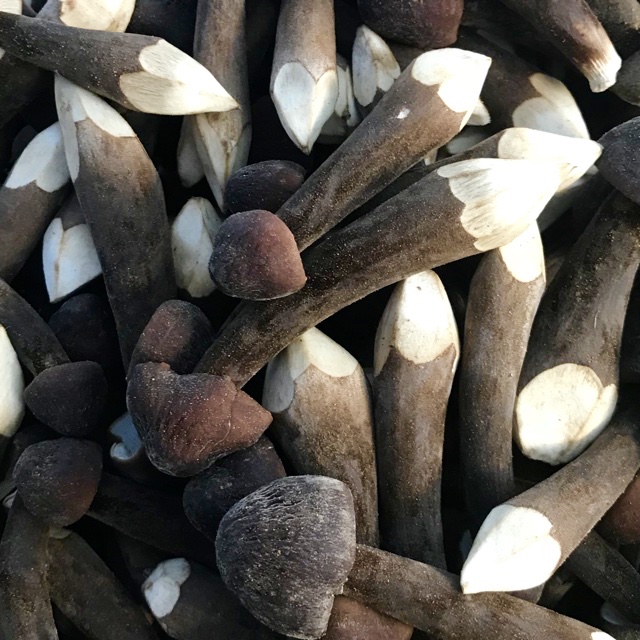
| Int. trade name | ROYAL CHESTNUT |
| LATIN | Xerula furfuacea |
| NL | Beukwortelzwam |
| EN | Beech rooter or Rooted agaric |
| FR | Chestnut royale |
| DE | Royal chestnut (oder 'Holzkeule' ?) |
| ES | Chestnut real |
| SEASON | year round |
| HIGH SEASON | year round |
| ORIGIN | Asia |
| SORTING | Mixed sizes |
This beautiful mushroom is extremely decorative because of its intense gray-brown, sometimes almost black color and white-cream colored inside of the hat. The hat of young specimens is soft and velvety.
Royal chestnuts have a beautiful and rich forest aroma with clear tones of nuts and a slight sweetness. The foot and the hat have a fleshy inside. The outside of the stem gives this mushroom a big 'bite' that is reminiscent of green asparagus.
Favorite among chefs because of the nutty taste and the firm structure. Widely used in soups, stews and specially in stirr fried dishes.
The Royal chestnut grows wild in central China, India and Zambia, among others. There are about 30 species, most of which are edible. In China they are increasingly cultivated and now also available for us. According to the Chinese, it has a beneficial effect.
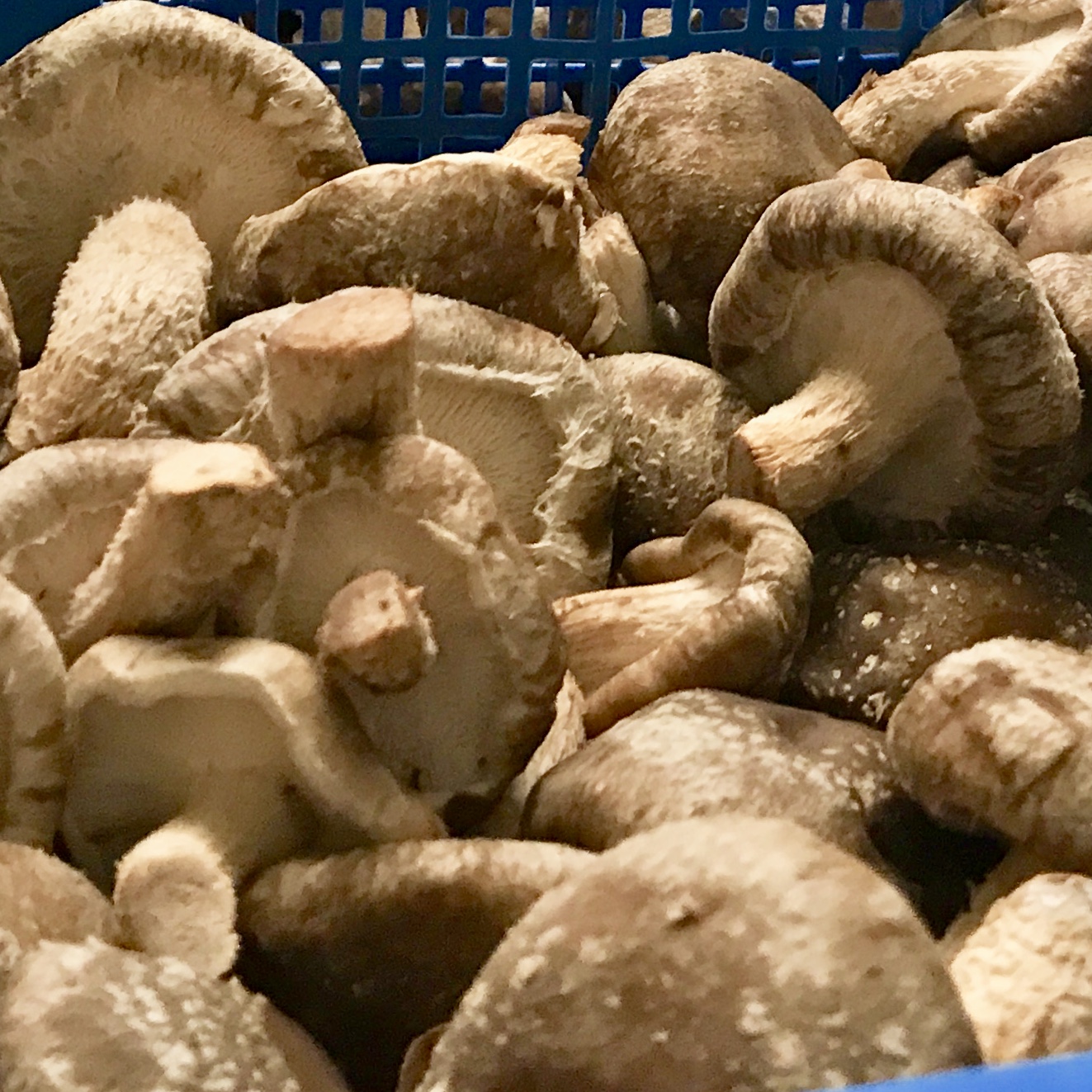
| Int. trade name | SHIITAKE |
| LATIN | Lentinus edodes |
| NL | Shiitake |
| EN | Shiitake |
| FR | Shiitake |
| DE | Shiitake |
| ES | Shiitake o Hongo del árbol shii |
| SEASON | Year round |
| HIGH SEASON | Year round |
| ORIGIN | CN / EU |
| SORTING | Mixed sizes |
Shiitake have a fixed structure and should not be washed. Wipe off if necessary with kitchen paper. Shiitake absorb moisture easily, but hardly lose any moisture during baking. Quick stir-frying gives the best results. Otherwise, chances are that they will become tough. Often used in Asian cuisine, in stir-fries, soups and sauces.
In addition, you can prepare Shiitake in countless ways and vary with it!
Shiitake grow in nature in Japan and China. The mushroom grows on hard woods such as oak, beech, chestnut and walnut.
After the mushroom, the Shiitake is the most grown. In China, because of its scent, Shiitake is also called 'xiang gu', which means 'good-smelling mushroom'. There are two types on the market; the most sold is the 'tong gu' species, which is thick and meaty with a barely opened hat. The thin-fleshed species with a wide open hat is called 'koshin'. Lowers cholesterol and blood pressure.
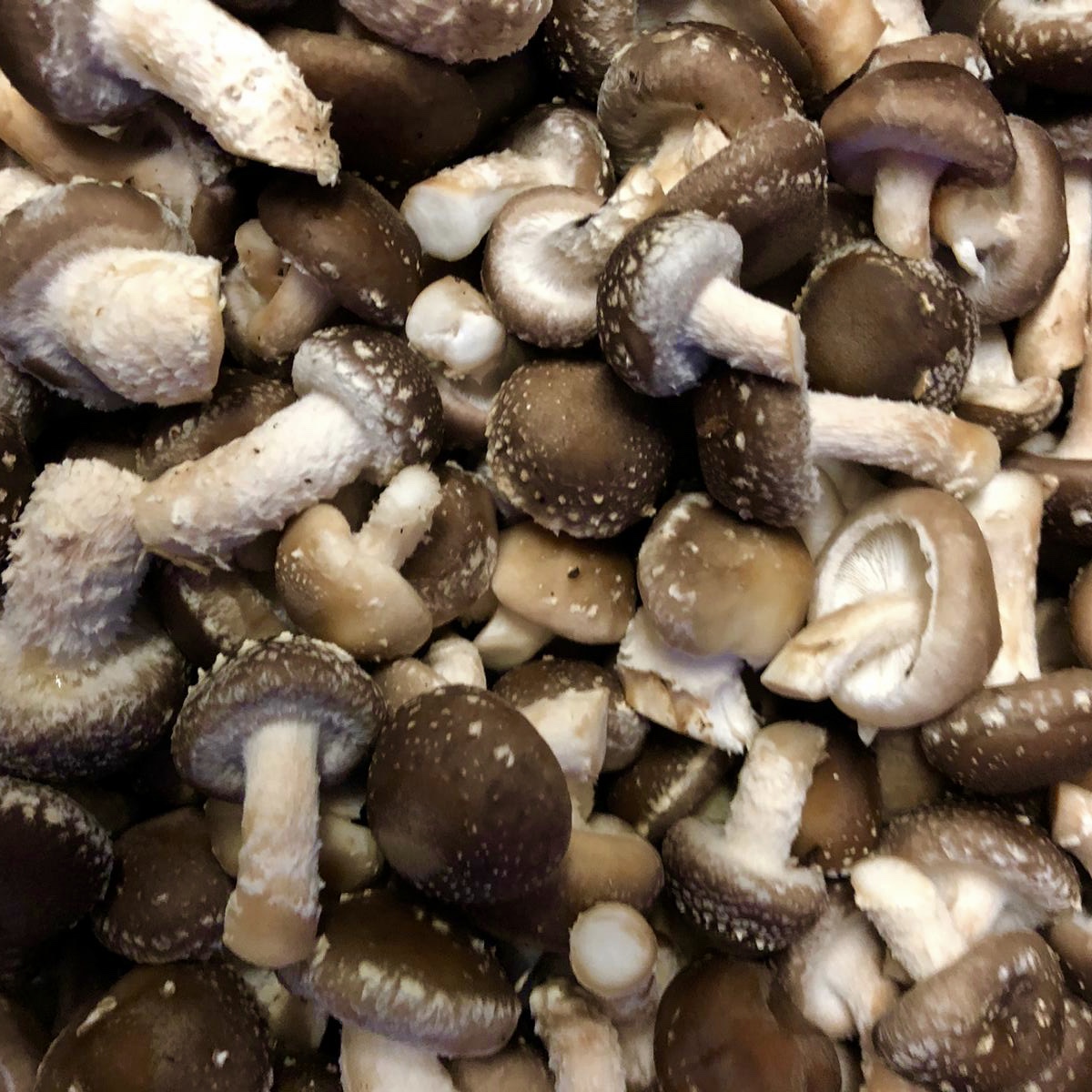
| Int. trade name | SHIITAKE [ MINI ] BIO |
| LATIN | Lentinus edodes |
| NL | Mini Shiitake |
| EN | Mini Shiitake |
| FR | Shiitake mini |
| DE | Mini Shitake |
| ES | Shiitake mini |
| SEASON | Year round |
| HIGH SEASON | Year round |
| ORIGIN | NL / EU |
| SORTING | Bio & mixed sizes [ 1 - 3 cm ] |
E a t t h e f e e t ! !
The feet of our mini Bio Shiitake cultivated in the Netherlands are nice and soft. Just like the hats. Specially grown with preservation of the spicy, spicy Shiitake taste and pleasant odor. So hardly any cleaning and complete processing! And that makes every chef happy! A tasteful and decorative mushroom that can be eaten whole (only cut off the end of the foot).
Shiitake have a fixed structure and should not be washed. Wipe off if necessary with kitchen paper. Shiitake absorb moisture easily, but hardly lose any moisture during baking. Quick stir-frying gives the best results.
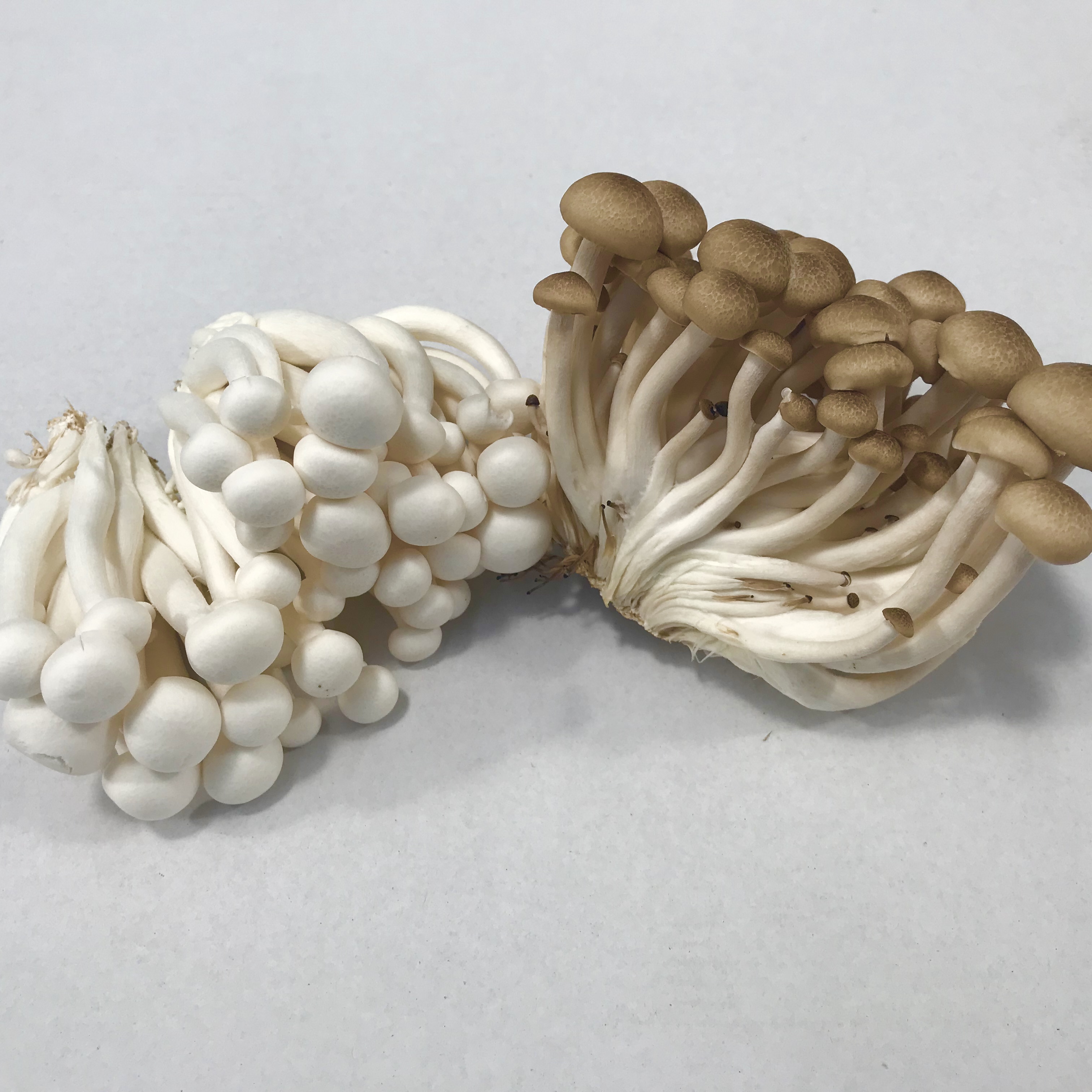
| Int. trade name | SHIMEJII |
| LATIN | Hypsizygus tessullatus |
| NL | Beukenzwam (wit en bruin) |
| EN | Beech mushroom (white and brown) |
| FR | Champignon d'hêtre (blanc et brun) |
| DE | Buchenpilz (weiß und braun) |
| ES | Shimejii (blanco y marrón) |
| SEASON | Year round |
| HIGH SEASON | Year round |
| ORIGIN | EU / Asia |
| SORTING | In bundles |
The taste is very pleasant and nutty. Also of decorative value in countless dishes. The beech mushroom does not lose moisture during preparation and therefore retains its shape. Remains nice and crispy in short cooking.
In principle, cleaning does not have to be done. Only remove the bottom piece of the stem. You store them best in the refrigerator and on the substrate.
Beech mushrooms grow in bundles. In nature on beeches in particular and originates in East Asia. In Japan a popular mushroom ('Shimejii'). The cultivated white beech mushroom grows in the dark. For both the white and brown Shimejii, it is better not to eat them raw; the mushroom is poorly digestible and has a bitter taste. This disappears completely after heating.
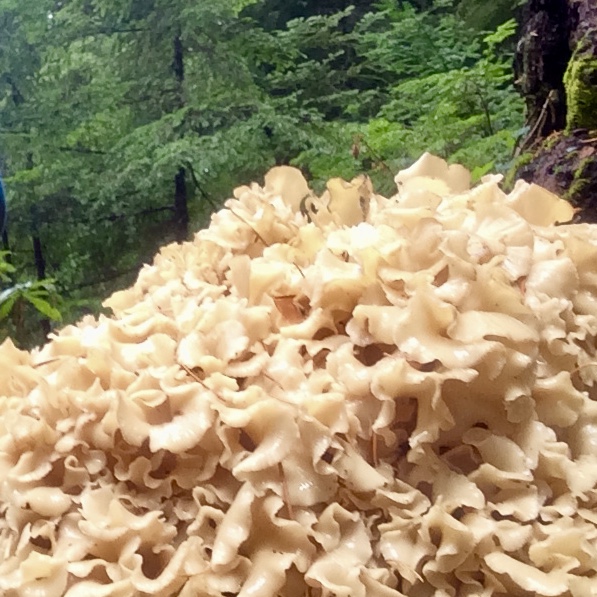
| Int. trade name | SPARASSIS |
| LATIN | Sparassis crispa |
| NL | Grote sponszwam |
| EN | Cauliflower fungus |
| FR | Clavaire crépue ou Chou-fleur |
| DE | Krause Glucke oder Fette Henne |
| ES | Seta coliflor o Clavaria rizada |
| SEASON | year round |
| HIGH SEASON | year round |
| ORIGIN | EU |
| SORTING | Mixed sizes |
You can eat Cauliflower mushrooms best when they are young, firm and white to yellow in color. The meat is firm and elastic to crispy and in Latin it's called the 'Sparassis crispa'. The smell is wonderfully sweet. The taste is nice spicy and clearly mushroom, nutty and with a hint of nutmeg.
Despite their distinct appearance, you can prepare them like any mushroom. Special attention however for cleaning. Due to the special structure, the Cauliflower mushroom can sometimes have some sand between the slats. No problem !! First cut them into pieces of the same size and then rinse under running water. Immediately pat dry and ready !!
The Cauliflower mushroom is fairly common in the wild in Europe and North America. With us from August to November. Grows on thick, deep underground stumps of old pines. Thanks its Dutch name ('Large sponge mushroom') to the resemblance with an old-fashioned bath sponge.








